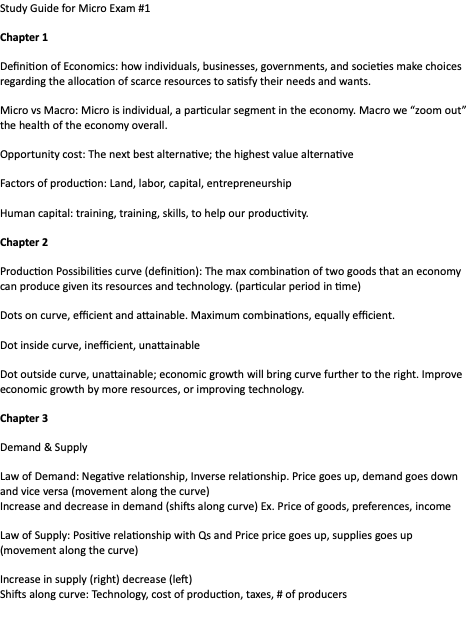Micro Study Guide
Study Guide for Micro Exam #1
Chapter 1
Definition of Economics: how individuals, businesses, governments, and societies make choices regarding the allocation of scarce resources to satisfy their needs and wants.
Micro vs Macro: Micro is individual, a particular segment in the economy. Macro we “zoom out” the health of the economy overall.
Opportunity cost: The next best alternative; the highest value alternative
Factors of production: Land, labor, capital, entrepreneurship
Human capital: training, training, skills, to help our productivity.
Chapter 2
Production Possibilities curve (definition): The max combination of two goods that an economy can produce given its resources and technology. (particular period in time)
Dots on curve, efficient and attainable. Maximum combinations, equally efficient.
Dot inside curve, inefficient, unattainable
Dot outside curve, unattainable; economic growth will bring curve further to the right. Improve economic growth by more resources, or improving technology.
Chapter 3
Demand & Supply
Law of Demand: Negative relationship, Inverse relationship. Price goes up, demand goes down and vice versa (movement along the curve)
Increase and decrease in demand (shifts along curve) Ex. Price of goods, preferences, income
Law of Supply: Positive relationship with Qs and Price price goes up, supplies goes up (movement along the curve)
Increase in supply (right) decrease (left)
Shifts along curve: Technology, cost of production, taxes, # of producers
Equilibrium characteristics: Qd = Qs (No surplus or shortage) Best point, producers and consumers equally as happy with the price.
Shortage: Below equilibrium price (p*); increase price to solve shortage because its increase in demand and that decreases it.
Surplus: Above equilibrium price (Q*); Qs > Qd; fix by lowering price.
Changes in equilibrium
